338Canada: The Conservatives surge, the Liberals slide
Philippe J. Fournier: The latest 338 projection shows the Liberals falling two seats per day since the campaign began. The Conservatives are the new favourites.
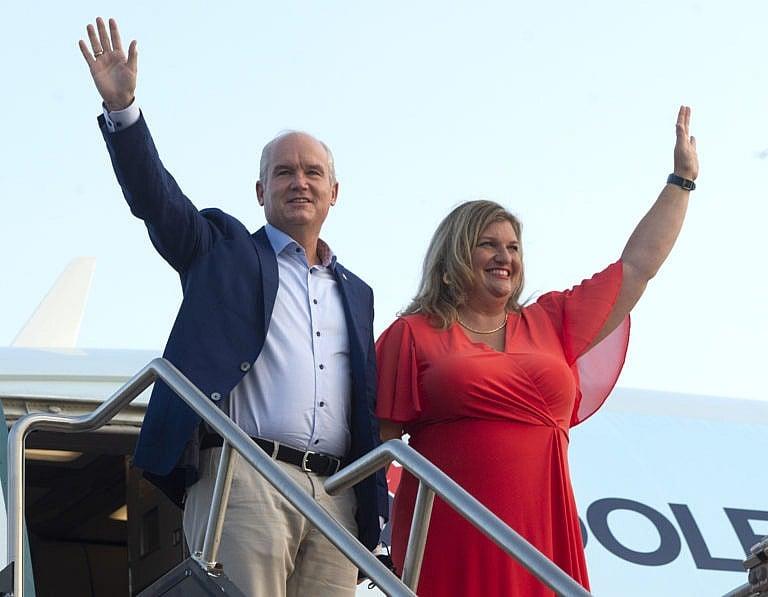
O’Toole and his wife, Rebecca, board their campaign plane for a flight to Hamilton, Ont. on Aug. 25, 2021 in Ottawa (Ryan Remiorz/CP)
Share
It was (another) difficult week for Justin Trudeau’s Liberals in public opinion polls. The trends we observed in the first week of this short campaign continued and even intensified in the second week. With support for the Liberals in a downward spiral in key regions of Canada, several polls now show the Conservatives have taken the lead in voting intentions in the country. In the latest seat projections, Conservatives and Liberals may now stand neck-in-neck, but the all-important “momentum” of this campaign is clearly on the side of Erin O’Toole’s team.
Let’s take a look back at the polls of the past week:
- Earlier last week, the Angus Reid Institute, Léger, Abacus Data and Ipsos all released figures indicating that the Liberals had lost ground during the first week of the campaign. With tighter voting intentions (particularly in Ontario), these internet panel polls gave the Liberals national leads between one and four points over the Conservatives. We look forward to these firms’ newest figures next week to whether the Liberal Party has slowed this trend.
- According to the three polling firms with daily rolling polls, namely Mainstreet Research, EKOS and Nanos Research, support for the Liberals fell significantly as the week went along while the Conservative Party (CPC) surged ahead. As of this morning, Nanos has the CPC leading by a modest 2-point margin, whereas EKOS and Mainstreet measure the CPC much further ahead, by 6 and 10 points respectively over the Liberals. All three pollsters now show a statistical tie in Ontario, and all have the CPC regaining levels of support comparable to those of 2019 in Western Canada—a region which, since the election of Erin O’Toole to the leadership of the CPC in August 2020, initially seemed lukewarm to the new Conservative leader.
- Support for the NDP remained generally stable during the week with national support between 19 and 22 per cent. Jagmeet Singh’s team is projected for potential gains in Ontario and appear to have boosted its support somewhat in the Prairies. In Quebec, we will have to watch whether the return of former MP Ruth Ellen Brosseau will move the needle in the province. Obviously, without local polling in the riding of Berthier-Maskinongé, it will be difficult to know whether Brosseau has a realistic chance of taking over the riding she narrowly lost to the Bloc Québécois in 2019, but her return is positive news for Singh in Quebec.
- For the Bloc Québécois, last week’s polls all indicate support below 30 per cent in Quebec. With figures ranging from 23 to 29 per cent in the province, the support for the Bloc appears to have declined since 2019, hence some ridings narrowly won by the BQ in 2019 could be in danger of changing colours. Moreover, with the rise in popularity of Erin O’Toole elsewhere in the country, Yves-François Blanchet will have to adjust his strategy to keep his party’s in-roads from 2019, especially in the Quebec City area and among older, traditionally more right-of-centre voters, whom the CPC is targeting.
- The Green Party of Canada is in serious danger of falling off the map in this election. According to current projections, Green MP Paul Manly could be in danger of losing his riding of Nanaimo-Ladysmith on Vancouver Island (currently in a three-way fight with the Conservatives and the NDP). If the trend continues, former leader Elizabeth May could, once again, find herself the only elected member of her party.
- Finally, polls differ somewhat as to the support for Maxime Bernier’s People Party. The Mainstreet and EKOS IVR polls have measured national support of up to 6 and 7 per cent for the PPC, but other polling firms measure the party in the 2 to 4 per cent range instead. Can Bernier get elected in his home riding of Beauce? This is difficult to assess for the moment, especially since it is in Quebec where PPC support is lowest among the traditional survey regions in Canada.
Here are the 338Canada updated vote projections. We note that the Conservative Party has taken the lead for the first time since the start of the pandemic. However, the current gap between the CPC and the Liberals remains inferior to the projection’s uncertainty, therefore we must still call this a statistical tie between the two parties:
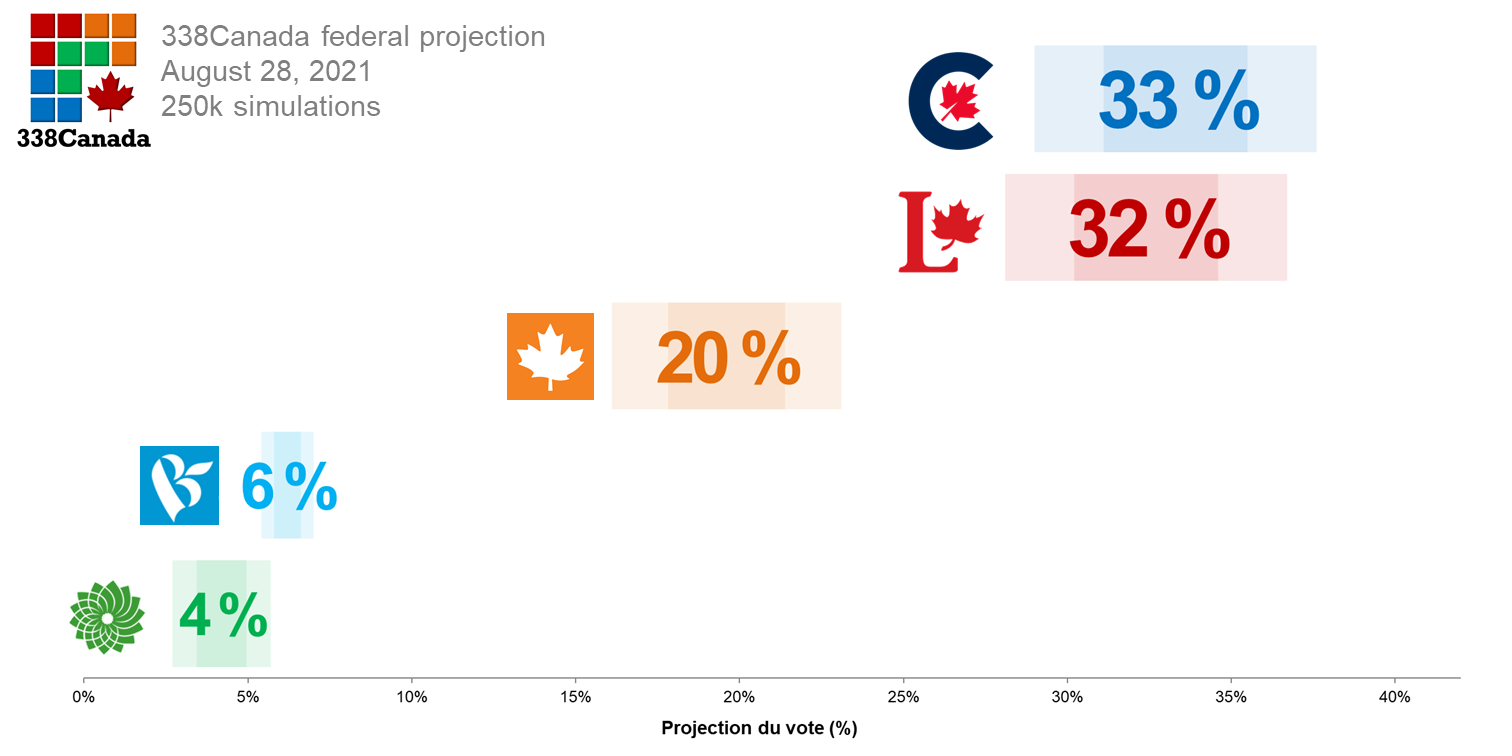
Nonetheless, even though it technically is a statistical tie, one party is in decline since the writ has dropped on Aug. 15, and the other has been gaining ground since day one of the campaign. Here are the vote projections since the beginning of August. While the NDP and BQ have remained generally stable, the lines at the top are clearly moving in opposite directions:
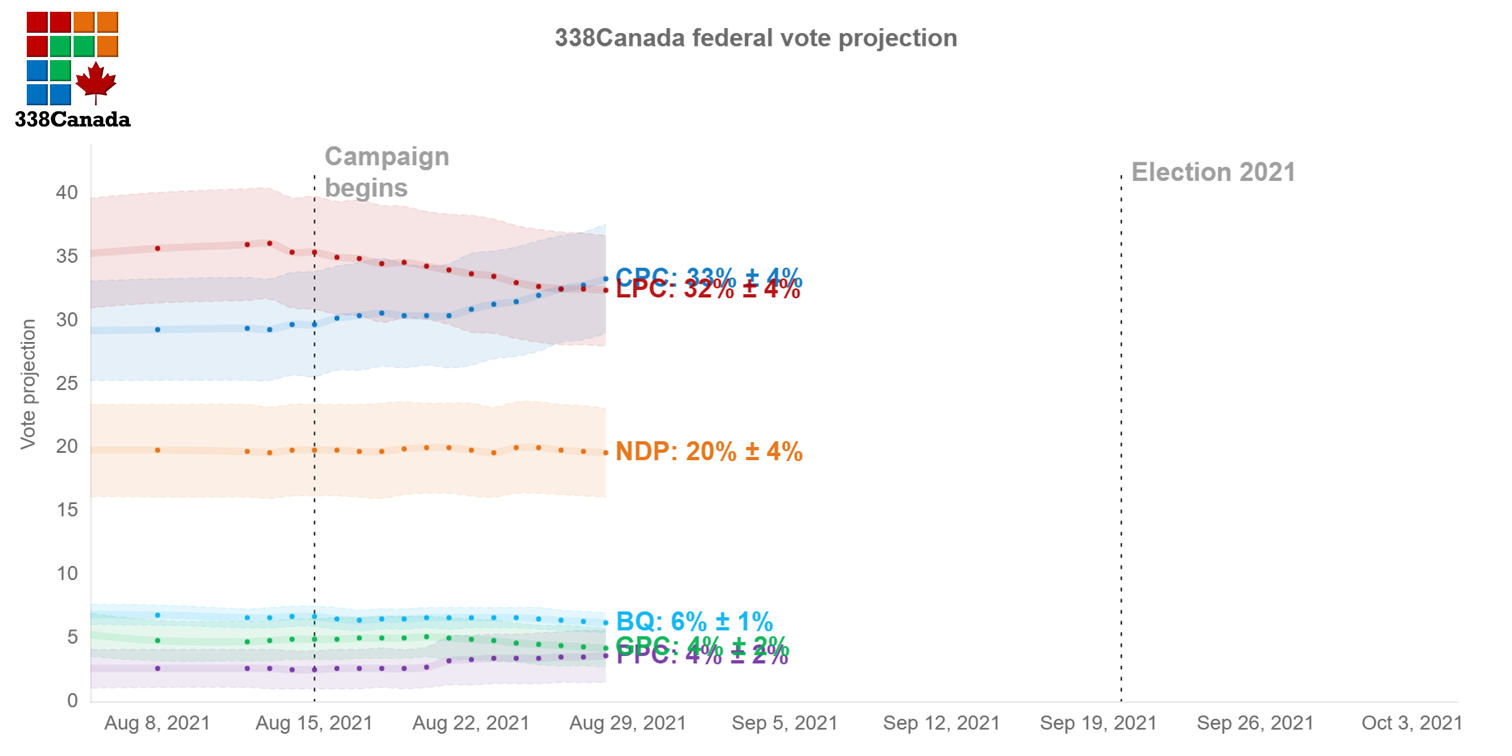
Seat-wise, the Liberals have fallen to an average of 140 seats from coast to coast, and the Conservatives have caught up to them:
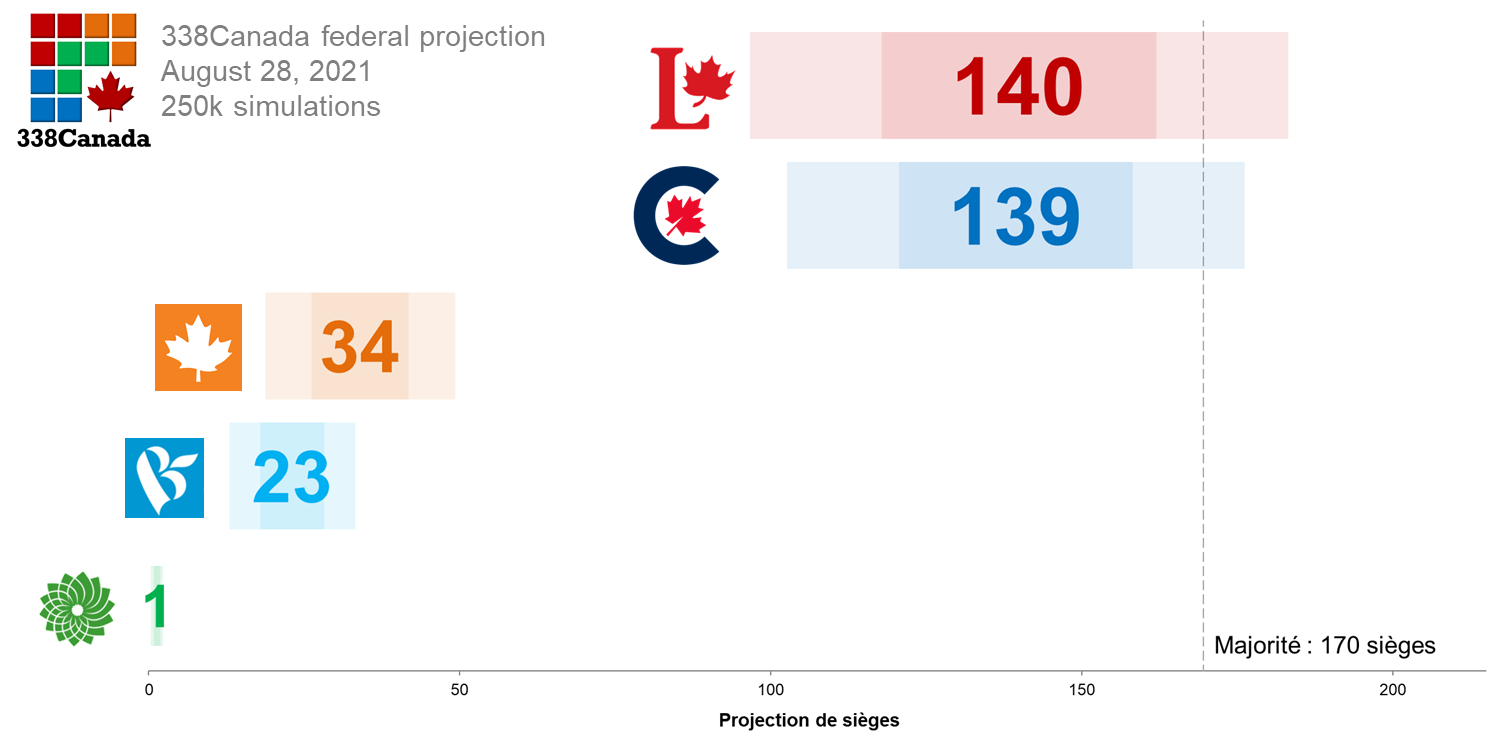
While the seat projections of the Liberal Party and the Conservative Party overlap around the same values, it is worth noting that in my column published two weeks ago, the Liberals stood at an average of 166 seats. The Liberals have therefore fallen by an average of two seats per day since the campaign began, and we do not know yet whether that slide has stabilized.
The most significant movement in vote intentions comes from Ontario. When the campaign began, the Liberals held an average lead of 10 points over the Conservatives. Both parties are now tied in the province, and the seat projections in Ontario have moved accordingly:
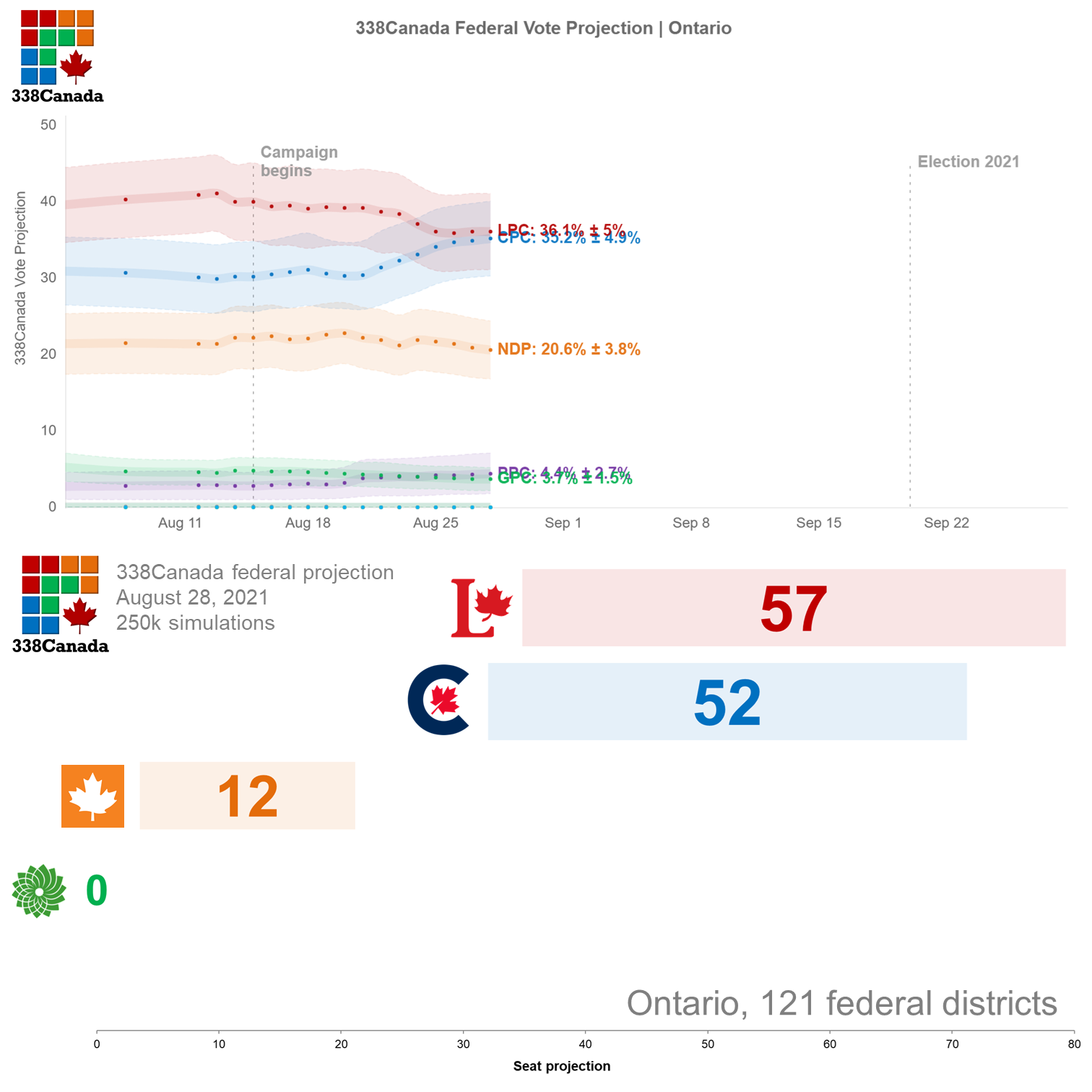
We also should not dismiss the CPC surge in British Columbia in the past two weeks. Even though regional sample sizes in federal polls are smaller for B.C. than Ontario and Quebec (and therefore should be used with caution), we nevertheless observed significant movement in favour of the Conservatives at the expense of the Liberals in the province. Whereas the Liberal Party appeared on its way to make gains in B.C. merely two weeks ago, it now appears it will have to fight for many of the seats it won in 2019:

In Quebec, we have not yet observed any notable movement in voting intentions since the campaign was launched. In fact, with the exception of the Bloc’s modest decline, voting intentions in the province remain essentially stuck to the results of the 2019 election. Nevertheless, if the Bloc does indeed stand below the 30 per cent mark, this would most likely benefit the Liberals, and could potentially translate into additional Liberal Quebec seats. The first French debate on the TVA (Québécor) network will occur this Thursday (Sept. 2), so we will watch the numbers in Quebec closely this week.
Against all expectations just last month, the Conservatives should now be perceived as the favourites to win the most seats in Canada. Granted, today’s update puts the Liberals and the CPC in a statistical tie, but one party is in free fall while the other has been on the rise. The question is therefore: Will the CPC be able to maintain this momentum in public support until election day?
In 2015 and 2019, Justin Trudeau had his best campaign performances as the underdog in the race. Will he manage to repeat this feat, or will the 2021 campaign become “the one campaign too many” for Trudeau? What at first appeared to be a boring federal campaign has become anything but.
* * *
Details of this projection are available on the 338Canada page. To find your home district, use this list of all 338 electoral districts, or use the regional links below: